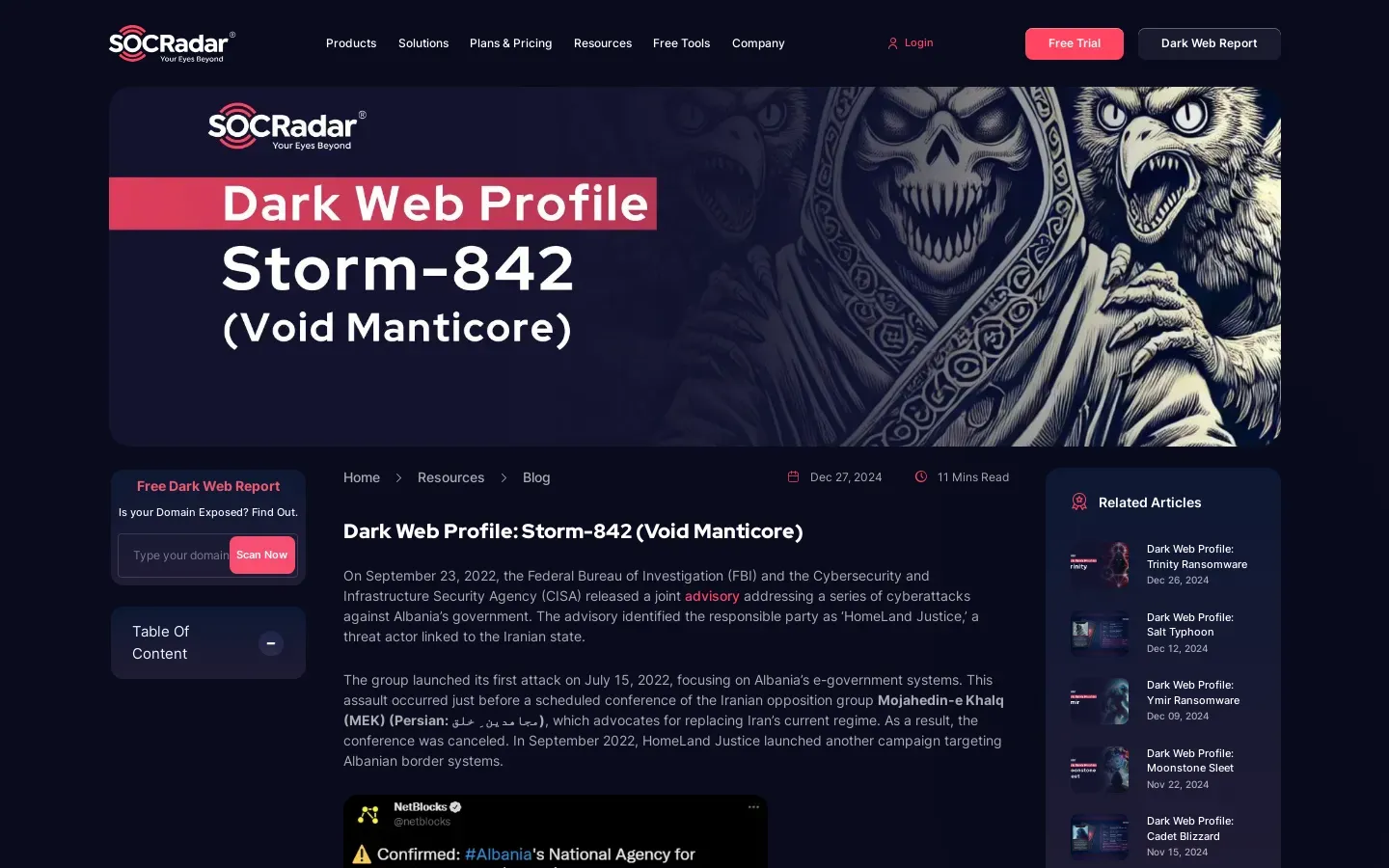
Iranian Threat Actor Storm-842's Cyberattack Tactics Revealed
/ 4 min read
Quick take - Recent research has analyzed the sophisticated cyberattacks attributed to the Iranian threat actor Storm-842, highlighting the need for organizations to adapt their cybersecurity strategies to address both technical and psychological threats in modern cyber warfare.
Fast Facts
-
Storm-842 Overview: The Iranian threat actor, Storm-842 (Void Manticore), employs sophisticated cyberattacks that combine technical incursions with psychological operations to influence public perception and sow discord.
-
Attack Methodology: Their multi-layered approach includes target identification, coordinated attack execution, deployment of custom malware and wipers, and psychological influence campaigns.
-
Evolving Threat Landscape: Organizations must adapt their cybersecurity strategies to address both technical threats and the psychological impacts of cyber warfare, recognizing the dual nature of modern attacks.
-
Cybersecurity Enhancements: Recommendations include developing advanced threat detection systems, enhancing cyber resilience frameworks, fostering international collaboration, and researching psychological warfare tactics.
-
Research Limitations: While the study provides valuable insights into Iranian APT tactics and vulnerabilities, it has limitations, such as a narrow focus on specific attack vectors and the need for further exploration of long-term impacts on international relations.
Unveiling Storm-842: The Sophisticated Cyberattacks of an Iranian Threat Actor
Recent research has brought to light the intricate cyberattacks orchestrated by the Iranian threat actor known as Storm-842, or Void Manticore. This revelation underscores the evolving nature of cyber warfare, highlighting the urgent need for organizations to adapt their cybersecurity strategies to counteract both technical and psychological threats posed by modern adversaries.
Overview of Cyberattack Methodology
The study reveals a multi-layered approach employed by Storm-842, characterized by several critical stages:
Target Identification and Reconnaissance
Storm-842 meticulously identifies potential targets, gathering intelligence to understand their vulnerabilities and operational structures. This foundational step is crucial for planning effective attacks, allowing the group to tailor their strategies to exploit specific weaknesses.
Coordinated Attack Execution
Following reconnaissance, the group executes attacks in a synchronized manner, maximizing impact while minimizing detection. This precision demonstrates their strategic planning capabilities, enabling them to disrupt operations effectively.
Deployment of Custom Malware and Wipers
The attacks often involve sophisticated malware tailored to exploit specific vulnerabilities within target systems. Additionally, wipers are used to erase critical data, further compounding the damage inflicted on victims and complicating recovery efforts.
Psychological Operations and Influence Campaigns
Beyond technical incursions, Storm-842 employs psychological tactics aimed at influencing public perception and sowing discord. This highlights the dual nature of modern cyber warfare that encompasses both technical and psychological dimensions, posing a multifaceted threat to organizations.
Implications for Cybersecurity
The findings from this research underscore several practical and theoretical implications for the cybersecurity landscape:
-
Evolving Threat Landscape: Organizations must recognize that cyber threats are no longer purely technical; they encompass psychological warfare that can influence public opinion and organizational stability.
-
Need for Adaptation: There is an urgent need for organizations to adjust their cybersecurity strategies to address these evolving threats. This involves focusing not only on technological defenses but also on mitigating the psychological impact of cyber operations.
Strengths and Limitations of the Research
The research boasts notable strengths, including a comprehensive analysis of advanced tactics employed by Iranian APT groups and the identification of critical vulnerabilities in current cybersecurity frameworks. However, it also presents limitations, such as a narrow focus on specific attack vectors and the need for further investigation into the long-term impacts of these cyber operations on international relations and cybersecurity policies.
Tools and Techniques for Enhanced Cybersecurity
In response to the threats posed by Storm-842, the research outlines several essential tools and frameworks that can bolster cybersecurity defenses:
-
Development of Advanced Threat Detection Systems: These systems are designed to identify and neutralize threats in real-time, enhancing the ability to respond to sophisticated attacks.
-
Enhanced Cyber Resilience Frameworks: Organizations are encouraged to adopt frameworks that promote resilience, ensuring they can recover quickly from cyber incidents.
-
International Collaboration and Information Sharing: Strengthening partnerships among nations and organizations can facilitate the sharing of crucial threat intelligence, improving collective defenses against cyber adversaries.
-
Psychological Warfare and Influence Operations Research: Further exploration of psychological operations in cyber warfare can provide insights into countering influence campaigns and mitigating their effects on targeted populations.
The cyberattacks attributed to Storm-842 serve as a stark reminder of the complexities and dangers of modern cyber warfare. As the threat landscape continues to evolve, organizations must remain vigilant and proactive in enhancing their cybersecurity measures to defend against sophisticated and multifaceted attacks. By prioritizing both technical defenses and the psychological aspects of cyber warfare, entities can better protect themselves in an increasingly hostile cyber environment.



